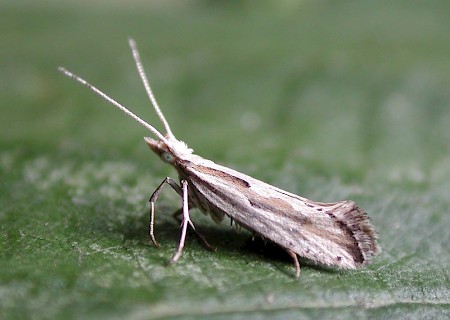18.003 BF465
Plutella porrectella
(Linnaeus, 1758)
Wingspan 14-17 mm.
This close relative of the familiar Diamond-back Moth (Plutella xylostella) is slightly larger and more striated in appearance. The antennae have three darkish rings toward the tip.
It is fairly common in Britain in the vicinity of the foodplant. It flies during May and again in July to August. It is nocturnal and is attracted to light, and can be easily disturbed from the foodplant by day.
The larval foodplant is Dame's violet (Hesperis matronalis), also known as Sweet rocket or Damask violet. The larvae feed in April-May and June-July, distorting or connecting the leaves with a small amount of silk.
It pupates in a distinctive white silk cocoon with a large open mesh, on the underside of a leaf.
- Larva: (description Ian F. Smith):
Foodplant: Hesperis matronalis April-May and June-July. In a small amount of silk, curling or connecting leaves.
Length: 10 mm described [8 mm variations in brackets]
Head: Slightly silky. Dull yellowish green [8 mm dull yellowish]. Posterior two thirds with large blackish grey [8 mm brownish grey] marks grouped dorsally and laterally. A few dark marks in adfrontal area and in frons. Black [8 mm dark brown] posterolateral mark. Mouthparts reddish brown. Stemmatal area black
Prothorax (T1): Greenish white [8 mm whitish mustard]. Prothoracic shield weakly sclerotised, greenish white [8 mm whitish mustard], with about twenty black spots. No discernible medial dividing line.
Thorax (T2&T3): As abdomen [8 mm slightly greyish laterally].
Thoracic legs: Transparent tinted brownish [8mm similar to venter]. Black spot on either end of tibia. Base of leg as venter, with greyish black band around outer face. Body: Tapered at both ends. Whitish green [8 mm dull mustard]. Contractile dorsal vessel shows indistinctly as slightly darker dorsal line.
Spiracles: Small. Peritreme dark brown. [8 mm pitchy brown].
Pinacula: Weakly sclerotised, slightly paler than integument. Strong black spot around base of each seta. On dorsolateral pinaculum on thorax, the two setal spots merge.
Setae: Black. Abdominal pinacula unisetal. Thoracic pinacula bisetal on dorsum and dorso-laterally.
Anal segment: Similar to abdomen [8 mm paler than abdomen]. No anal comb. Anal plate weakly sclerotised, coloured as abdomen. Grey dots arranged in medial line, and transverse line near anterior.
Prolegs: Thin, tubular, transparent, tinted greenish [8 mm yellowish]. Anal prolegs stouter. Crochets black.
Pupa: Very active if disturbed. 9mm. Light green. Head translucent whitish, slightly tinted reddish brown. Black eyes visible within. Posterior two segments whitish tinted reddish brown. Spiracles on conical projections. Four pairs of bright reddish brown perianal hooks. Six sturdy bright reddish brown caudal hooks on posterior of pupa. Proboscis not quite as long as mesothoracic leg. Cocoon whitish silk, flimsy large mesh.

 UKMoths
UKMoths 







